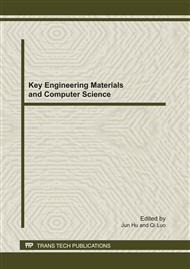[1]
Tiehui Qin: Information is the basic of decision. Shenyang Teacher-training University. VOL2005, No. 6.
Google Scholar
[2]
Lee, H., and Choi, B: Knowledge management enablers, processes, and organizational performance: An integrative view and empirical examination. Journal of Management Information Systems. Vol. 20(2003), No. 1: p.179.
DOI: 10.1080/07421222.2003.11045756
Google Scholar
[3]
Xiang Tao and Zuozhi Zhang: Competitive environment Monitoring. (Huaxia Press Beijing 2003).
Google Scholar
[4]
Changhuo Bao and Xinzhou Xie: Competitor Analysis. (Huaxia Press Beijing 2003).
Google Scholar
[5]
W.R. Dill: Enviroment as an Influence on Managerial Autonomy, Administrative Science Quarterly. Vol. 1(1958) No. 2: p.409.
Google Scholar
[6]
A.D. Chandler: Strategy and Structure. (MIT Press, Cambridge, MA 1962).
Google Scholar
[7]
H.I. Ansoff: Corporate Strategy: An Analytic Approach to Business Policy for Growth and Expansion . (McGraw-Hill Press, New York 1965).
Google Scholar
[8]
F.J. Aguilar: Scanning the Business Enviroment. (MacMillan Co Press, New York 1967).
Google Scholar
[9]
K.R. Andrews: The Concept of Corporate Stragegy. (Dow Jones-Irwin Press, Homewood, IL 1971).
Google Scholar
[10]
W.R. King and D.I. Cleland: Environmental Information Systems for Strategic Marketing Planning . Journal of Marketing. Vol. 38(1974): p.35.
DOI: 10.2307/1250389
Google Scholar
[11]
J. Wolfe. The Value of Environmental Cognition: a Simulation-based Test of Emerge and Trists Causal Textures, proceedingd of the Academy of Management. Aug, (1976).
Google Scholar
[12]
M.E. Porter: The Competitive Strategy: Techniques for Analyzing Industries and Competitors. (The Free Press, New York 1980).
Google Scholar
[13]
H.A. Simon. New Science Management Decision. (China Social Sciences Press, China 1982).
Google Scholar
[14]
W.F. Glueck and L.R. Jauch: Business Policy and Strategic Management. (McGraw Hill, 1984).
Google Scholar
[15]
S.C. Jain: Environmental Scanning in U.S. Corporations. Long Range Planning. Vol. 17(1984): p.117.
Google Scholar
[16]
C.S. Bates: Mapping the Environmental: an Operational Environmental AnalysisModel. Long Range Planning. Vol. 18(1985): p.97.
Google Scholar
[17]
J.F. Preble: Corporate Use of Environmental Scanning, Michgan Business Rev. Vol. 30(1978): p.12.
Google Scholar
[18]
C.K. Prahalad and Hame: The Core Competence of the Corporation. (Havard Business Review. 1990).
Google Scholar
[19]
D.J. Collis and C.A. Montgomery: Competing on Resources: Strategy in the 1990s. (Havard Business Review. 1995 ).
Google Scholar
[20]
Bing Liu: Enterprise-based competitive intelligence tracking and monitoring of competitors . Information Science. Vol. 12(2007).
Google Scholar
[21]
Michael E. Porter: Competitive Strategy . (Huaxia Press. Beijing 2005).
Google Scholar
[22]
Fred R. David: Strategic Management. (Economic Science Press, Beijing 2006).
Google Scholar
[23]
Ying Chen: The mathematical representation during decision-making process. (Hebei University Press. Beijing 1999).
Google Scholar


